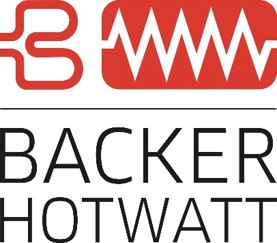Understanding Heater Types and Heat Transfer and Loss
At the simplest level, an electric heater is any device that changes electrical energy into heat energy. But depending upon what you wish to heat, the level of heat needed, and the method you intend to use to apply the heat, electric heaters can be configured in an infinite array of types, sizes, and applications.
The measure of electrical energy is called the Joule after its discoverer, James Prescott Joule. Through numerous experiments, Joule determined that the quantity (Q) of heat transferred from electrical energy is proportional to the square of the current (I 2) multiplied by the resistance (R) for the period of time (t) through which it passes:
Q ∝ I 2 × R × t
However, one seldom sees a reference to Joules used in modern electric circuits. Instead, the controlling factor becomes that of power (P):
P = I 2 × R
The only difference between the formula for determining power and that of determining Joules is the time component. The time factor in heating becomes readily apparent in any device that gets hot when an electric current flows through it: its temperature rises as time passes.
Selecting the Type of Electric Heater for Your OEM Application
Selecting the right heating element is crucial for controlling the environment of your application, ensuring safety, performance, and efficiency. Industries for medical devices, packaging equipment, laboratory and analytical equipment, semiconductor testing, food service, fuel cells, and opto-electronics rely on various heating element technologies.
Heaters come in many different styles and configurations, each design optimized for a specific application. The selection of a heater depends on the material being heated, the heater style, the sheath material that surrounds the heating element and protects it from the material being heated, and the operating voltage of the heater.
Styles of heaters include:
- Strip
- Ring
- Rope and cable
- Cartridge
- Tubular
- Band
- Immersion
- Circulation
- Process air and duct
- Radiant
- Comfort
- Flexible
- Tote
- Drum
The style of heater you choose depends on the application and the heated object’s shape, size, mass, and performance requirements. There are variety of sheath materials that can be used— including steel, Incoloy, iron, silicone, Kapton, copper, ceramic, and glass overbraid—each has different qualities, designed to accommodate specific materials.
For those unsure of the heater style needed, questions regarding available voltage, overall application, design envelope dimensions, and required wattage help determine the appropriate heater. Voltage availability and the nature of the material being heated are essential considerations for accurate heater selection. Additionally, understanding the dimensions of the design envelope and the desired operational temperature aids in choosing the right heater.
If you already know the heater style required, considerations such as wattage, voltage supply, design envelope dimensions, terminations, sheath material, special features, and quantities are important. Providing detailed information about the application allows for tailored recommendations and adjustments to accommodate design limitations. From custom flanges to oddball shapes, various additional options are available to meet specific application needs. Ultimately, understanding these factors ensures the selection of the most suitable heating element for your application, promoting optimal performance and efficiency.
We’ve written about heater selection in more detail in this blog—take a look.
Transfer of Heat
When a body starts to generate heat, meaning its temperature rises above that of other nearby objects, it is called a heat source. As its temperature rises, it starts to raise the temperature of the materials in its vicinity using any combination of three different methods: conduction, convection, and radiation.
Conduction transfers heat energy from one material to another via direct contact. It is the most direct method of transferring heat energy and is generally considered the most efficient.
Convection uses physical contact to transfer heat energy, in conjunction with use of an intermediary gas, typically air. The heat source warms the gas—producing a buoyancy effect— and as it rises, convection currents are created that move the heated gas into contact with the colder objects, warming them.
The third method, radiation, transmits heat energy through space from the heat source to the object in the form of electromagnetic radiation, typically as infrared wavelengths.
Heat Losses
All three methods of heat transfer can lead to heat losses. Heat losses occur when an object subjected to electric heating continues to become hotter, as long as current passes through it, until it reaches its burn out temperature and the heat source is destroyed.
Properly designed and used, modern electric heaters do not experience this burn out condition. But it is necessary to control heat losses—the transfer of heat away from the heat source—to optimize heater performance. We wrote about this in detail here.
Learn More About Electric Heating
Backer Hotwatt can help you determine the best heat source for your application. To learn more about electric heating, download our report on Basics of Electric Heaters.
The report includes:
- Types of Heaters
- Transfer of Heat
- Heat Loss
- Heat Equations
- Specific Applications
- Watt Density
Why Choose Backer Hotwatt
Backer Hotwatt Incorporated has been manufacturing custom and stock electric heating elements for over 65 years. Backer Hotwatt is a quality supplier to industrial users and original equipment manufacturers (OEMs) in the medical, commercial, packaging, instrumentation, aviation, transportation, refrigeration/air conditioning and military fields. Our heaters include cartridge, air process, immersion, strip and finned strip, tubular and finned tubular, band, foil, flexible Glasrope®, crankcase, and ceramic heaters. We’re here to help you heat things up! Contact Backer Hotwatt today about your heating application needs and questions.
